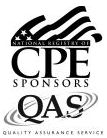Purchasing Guidebook (CPE Course)
CPE Credit: 14 hours
Course Type: Downloaded PDF materials with online test
Price (with PDF Textbook): $100

Course Description
The purchasing function has a dramatic impact on the profitability of a business, and so must be carefully managed. The Purchasing Guidebook
is an essential tool for doing so, since it shows how the department’s performance can be fine-tuned. The course focuses on supplier selection and management, the competitive bidding process, negotiations, and contract management. It also addresses the many ways in which purchasing can be used to control costs in the areas of inventory management, logistics, and quality, while also providing the financial tools to improve a number of purchasing decisions. In short, the Purchasing Guidebook
is a required toolkit for the purchasing professional.
Author: Steven Bragg
Course Number: PR1003
Table of Contents
Chapter 1. Overview of Purchasing
Chapter 2. Purchasing Processes
Chapter 3. Procurement Cards
Chapter 4. Supplier Selection
Chapter 5. Supplier Management
Chapter 6. Competitive Bidding
Chapter 7. Supplier Negotiations
Chapter 8. Contract Management
Chapter 9. Inventory Management Issues
Chapter 10. Logistics
Chapter 11. Spend Management
Chapter 12. Quality Management
Chapter 13. Cost Management
Chapter 14. Purchasing Financial Analysis
Chapter 15. Supply Chain Financing
Chapter 16. Purchasing Measurements
Chapter 17. Applicable Information Technology
Learning Objectives
-
Recognize the reporting relationships for a purchasing department, how the role of the department changes in a multi-division environment, the responsibilities of each position, and the purchasing manager’s responsibilities related to ethics.
-
Describe the process flows related to requisitions, purchase orders, and competitive bidding.
-
Identify the methods available for rolling out a procurement card system.
-
Specify the considerations and criteria involved in supplier selection.
-
Identify the methods used to attend to supplier needs, and recognize the contents of a supplier scorecard.
-
State the circumstances under which competitive bidding should be used, the types of supplier qualifications, and when a reverse auction might be a viable option.
-
Identify the situations in which negotiations may be needed, the types of positions that may be taken, and the characteristics of a successful negotiator.
-
Identify the types of clauses that may be included in a contract with a supplier, and the key differences between a contract and a purchase order.
-
Specify the costs associated with inventory, how inventory record accuracy can be improved, and how to mitigate the effects of a supply chain bottleneck.
-
Recognize the different types of shipping terms, logistics performance goals, and characteristics of the different types of transport.
-
Identify the uses to which a spend management system can be put, how it is used, and the expected outcome of a spend compliance program.
-
Define the concept of quality, identify the goals of six sigma, and note how a corrective action process is used.
-
Recognize the pricing systems used by suppliers, and how a target costing system works.
-
Specify the key points in a leasing agreement to negotiate, the advantages of using leases, the methods for improving the financial results of a business, and how to improve the learning curve experienced by suppliers.
-
Identify the circumstances under which a supplier is more likely to accept a supply chain financing offer.
-
Specify the measurements to use when attempting to reduce purchase orders and suppliers, and to emphasize the use of certified suppliers.
-
Identify the components of a material requirements planning system, and the types of electronic notifications that can be provided to a buyer by a seller.
Level: Overview
Instructional Method: QAS Self-Study
NASBA Category: Production
Prerequisites: None
Advance Preparation: None
Latest Review Date:March 2024
Program Registration Requirements: Click on "Purchase Course" near the top of this page to pay for and access the course. You will then be able to download the course as a PDF file, then take an on-line examination, and then download a certificate of completion if you pass the examination.
Program Refund Policy: For more information regarding administrative policies concerning complaints, refunds, and other matters, see our policies page.

AccountingTools, Inc. is registered with the National Association of State Boards of Accountancy (NASBA) as a sponsor of continuing professional education on the National Registry of CPE Sponsors. State boards of accountancy have the final authority on the acceptance of individual courses for CPE credit. Complaints regarding registered sponsors may be submitted to the National Registry of CPE Sponsors through its website: www.nasbaregistry.org .
The NASBA sponsor identification number for Accountingtools, Inc. is 115881.

AccountingTools is an IRS Approved Continuing Education Provider. We are compliant with the requirements for continuing education providers (as described in sections 10.6 and 10.9 of the Department of Treasury’s Circular No. 230 and in other IRS guidance, forms, and instructions). Our IRS Approved Continuing Education Provider number is 72821.

